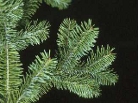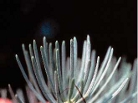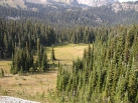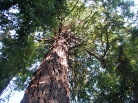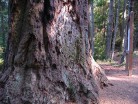
Grand Fir, Abies grandis (Douglas ex D. Don) Lindl.
Common Names: Balsam Fir, California Great Fir, Giant Fragrant Fir, Great Fir, Lowland White Fir, Oregon White Fir, Puget Sound Fir, Silver Fir, Stinking Fir, Tall Silver Fir, Western Balsam Fir, Yellow Fir
State List: CA, ID, MT, OR, WA
Visit the Image Gallery for more pictures
Synonyms:
Abies grandis (Douglas ex D. Don) Lindl. ssp. idahoensis (Silba) Silba
Abies grandis (Douglas ex D. Don) Lindl. var. grandis
Abies grandis (Douglas ex D. Don) Lindl. var. idahoensis Silba
Common Names: Balsam Fir, California Great Fir, Giant Fragrant Fir, Great Fir, Lowland White Fir, Oregon White Fir, Puget Sound Fir, Silver Fir, Stinking Fir, Tall Silver Fir, Western Balsam Fir, Yellow Fir
State List: CA, ID, MT, OR, WA
Visit the Image Gallery for more pictures
Synonyms:
Abies grandis (Douglas ex D. Don) Lindl. ssp. idahoensis (Silba) Silba
Abies grandis (Douglas ex D. Don) Lindl. var. grandis
Abies grandis (Douglas ex D. Don) Lindl. var. idahoensis Silba
Sources:
Trees of North America- A guide to field identification-a Golden Field Guide from St. Martin's Press © 2002 By C. Frank Brockman p.46
A Natural History of North American Trees, by Donald Culross Peattier © 2007 by Houghton Mifflin Company p. 127, 128
USDA, NRCS. 2011. The PLANTS Database (<http://plants.usda.gov/>, 22 August 2011). National Plant Data Team, Greensboro, NC 27401-4901 USA.
USDA, NRCS. 2011. The PLANTS Database, Plant Guide pg_abgr[1].docx
Howard, Janet L.; Aleksoff, Keith C. 2000 Abies grandis. In: Fire Effects Information System, [Online]. U.S. Department of Agriculture, Forest Service, Rocky Mountain Research Station, Fire Sciences Laboratory (Producer). Available: http://www.fs.fed.us/database/feis/ [2011, August 22].
Trees of North America- A guide to field identification-a Golden Field Guide from St. Martin's Press © 2002 By C. Frank Brockman p.46
A Natural History of North American Trees, by Donald Culross Peattier © 2007 by Houghton Mifflin Company p. 127, 128
USDA, NRCS. 2011. The PLANTS Database (<http://plants.usda.gov/>, 22 August 2011). National Plant Data Team, Greensboro, NC 27401-4901 USA.
USDA, NRCS. 2011. The PLANTS Database, Plant Guide pg_abgr[1].docx
Howard, Janet L.; Aleksoff, Keith C. 2000 Abies grandis. In: Fire Effects Information System, [Online]. U.S. Department of Agriculture, Forest Service, Rocky Mountain Research Station, Fire Sciences Laboratory (Producer). Available: http://www.fs.fed.us/database/feis/ [2011, August 22].
Photo citation: Steve Hurst @ USDA NRCS PLANTS Database

Want to add your tree to our picture gallery? Click here for details!
Tree lists:
•A-Z by scientific
name
•A-Z by common
name
•By Family
For state A-Z list click state name below.
•A-Z by scientific
name
•A-Z by common
name
•By Family
For state A-Z list click state name below.
-Color denotes a tree that is rare or endangered

Map courtesty USDA NRCS PLANTS Database

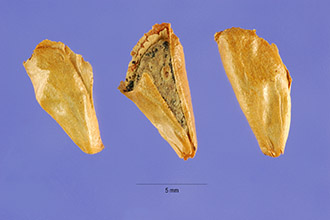
Abies grandis (Douglas ex D. Don) Lindl. f. johnsonii O.V. Matthews
Grand Fir, Abies grandis, is a native conifer found in western North America. It is a long lived handsome tree, normally reaching heights of 125 to 150 feet and 2 to 4 feet in diameter, with larger individuals tending to grow in the coastal reaches of its range. Montana is home to North America's current Champion tree, as listed in The American Forests Organization's 2012 National Register of Big Trees, which is an amazing 178 feet tall. Even though its growth rate is only moderate when compared to other tree species, it is the fastest growing fir species native to North America. Its shape, like a Christmas tree, is widest at the base, narrowing to a point at the top; however, older trees may have a more rounded crown. Like many trees, the bark also differs between young and old of this species. When young, Grand Fir bark is gray and mostly smooth, but broken up by resinous blisters under areas of new growth. As they mature, the bark turns varying shades between the gray of its youth and reddish brown and becomes ridged and furrowed. A single trunk supports dense foliage comprised of small .5 to 2 inch long blue-green needles. Forming in ranks of 2 on all but the upper most branches, the needles are shiny, waxy and have a sweet, orange-like aroma when crushed. The flat needles may be blunt or notched at the tips, with stomata located only on the silvery underside. Inconspicuous flowers bloom in late spring and give rise to small brown seeds encased in a papery sheath.
Grand Fir, Abies grandis, is a native conifer found in western North America. It is a long lived handsome tree, normally reaching heights of 125 to 150 feet and 2 to 4 feet in diameter, with larger individuals tending to grow in the coastal reaches of its range. Montana is home to North America's current Champion tree, as listed in The American Forests Organization's 2012 National Register of Big Trees, which is an amazing 178 feet tall. Even though its growth rate is only moderate when compared to other tree species, it is the fastest growing fir species native to North America. Its shape, like a Christmas tree, is widest at the base, narrowing to a point at the top; however, older trees may have a more rounded crown. Like many trees, the bark also differs between young and old of this species. When young, Grand Fir bark is gray and mostly smooth, but broken up by resinous blisters under areas of new growth. As they mature, the bark turns varying shades between the gray of its youth and reddish brown and becomes ridged and furrowed. A single trunk supports dense foliage comprised of small .5 to 2 inch long blue-green needles. Forming in ranks of 2 on all but the upper most branches, the needles are shiny, waxy and have a sweet, orange-like aroma when crushed. The flat needles may be blunt or notched at the tips, with stomata located only on the silvery underside. Inconspicuous flowers bloom in late spring and give rise to small brown seeds encased in a papery sheath.
Habitat
Found mainly between elevations of 1 to 5,000 feet, Grand Fir prefers north facing slopes with medium to coarse soil textures. In the Cascade Mountains, it is common up to 6,000 feet. Shade tolerant, this native species does well in moist areas near streams or in valleys. It requires 11 to 100 inches of annual rainfall, 60 frost free days and may survive temperatures down to -33°F. Abies grandis also is moderately drought tolerant but will draw more heavily than other species on available water sources.
Propagation
Seeds of Grand Fir require cold stratification for germination, and may remain viable for up to 5 years when properly stored. Seedlings should be
Found mainly between elevations of 1 to 5,000 feet, Grand Fir prefers north facing slopes with medium to coarse soil textures. In the Cascade Mountains, it is common up to 6,000 feet. Shade tolerant, this native species does well in moist areas near streams or in valleys. It requires 11 to 100 inches of annual rainfall, 60 frost free days and may survive temperatures down to -33°F. Abies grandis also is moderately drought tolerant but will draw more heavily than other species on available water sources.
Propagation
Seeds of Grand Fir require cold stratification for germination, and may remain viable for up to 5 years when properly stored. Seedlings should be
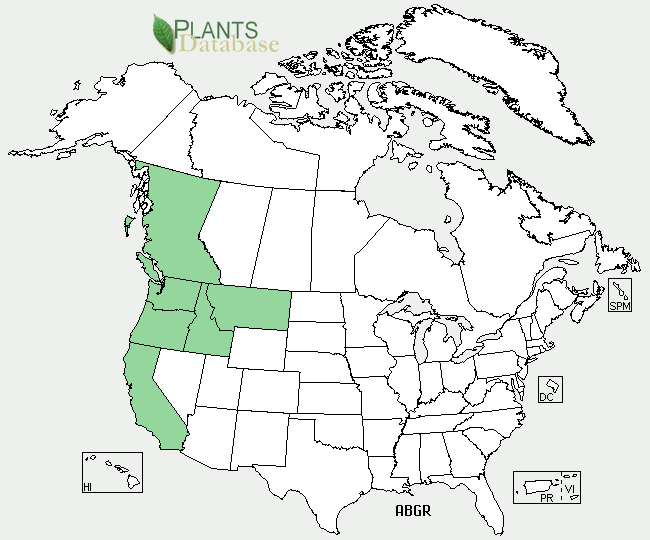
planted into their permanent locations before they reach 3 feet tall. Cone and seed production typically start when the tree is between 20 and 50 years of age.
Pests, Disease, and Elements
White Dwarf Mistletoe, Arceuthobium abietinum f. sp. concoloris, commonly plagues Grand Fir trees. It is also prone to several decay causing fungi, which tend to enter through wounds normally covered on other species by heavy sap excretion. Heart rots, in particular, are a leading cause of mortality and include Indian paint fungus, Echinodontium tinctorum, and Annosus, Fomes annosus. Many insect pests are found in association with Grand fir, among them are the western spruce budworm, various bark beetles, fire engraver beetles and the Douglas Fir Tussok moth. Grand fir has varying stages of fire resistance throughout its life cycle. When young, resinous blisters combined with thinner bark make it more susceptible to damage and mortality. As the tree ages, however, the bark becomes thicker and is resistant to low to moderately severe fires. Grand fir does not usually survive crown scorch at any stage. In addition to being moderately fire resistant and moderately drought tolerant, this native conifer is also capable of surviving periodic flooding along the steams and in the valleys it inhabits. Changes in the water table also do not severely impact this species.
Uses
Grand fir is a valuable timber tree and is used for pulpwood products, veneer, and nursery stock. It has the qualities of being lightweight, good for adhesives and has low shrinkage. Abies grandis is often farm grown for Christmas trees and use in landscaping. It is also useful on disturbed sites as it will grow well in many environments. Historic uses of this species are many. Native Americans and early settlers used boughs as an air freshener and the needles were burned as incense. Needles were also steeped as a tea for treating colds and crushed for use as baby powder. The pitch was rubbed into woods and scorched for a veneer effect, as well as made into a poultice for wounds, skin irritations and burns. It was also mixed with oils to make a deodorant.
Pests, Disease, and Elements
White Dwarf Mistletoe, Arceuthobium abietinum f. sp. concoloris, commonly plagues Grand Fir trees. It is also prone to several decay causing fungi, which tend to enter through wounds normally covered on other species by heavy sap excretion. Heart rots, in particular, are a leading cause of mortality and include Indian paint fungus, Echinodontium tinctorum, and Annosus, Fomes annosus. Many insect pests are found in association with Grand fir, among them are the western spruce budworm, various bark beetles, fire engraver beetles and the Douglas Fir Tussok moth. Grand fir has varying stages of fire resistance throughout its life cycle. When young, resinous blisters combined with thinner bark make it more susceptible to damage and mortality. As the tree ages, however, the bark becomes thicker and is resistant to low to moderately severe fires. Grand fir does not usually survive crown scorch at any stage. In addition to being moderately fire resistant and moderately drought tolerant, this native conifer is also capable of surviving periodic flooding along the steams and in the valleys it inhabits. Changes in the water table also do not severely impact this species.
Uses
Grand fir is a valuable timber tree and is used for pulpwood products, veneer, and nursery stock. It has the qualities of being lightweight, good for adhesives and has low shrinkage. Abies grandis is often farm grown for Christmas trees and use in landscaping. It is also useful on disturbed sites as it will grow well in many environments. Historic uses of this species are many. Native Americans and early settlers used boughs as an air freshener and the needles were burned as incense. Needles were also steeped as a tea for treating colds and crushed for use as baby powder. The pitch was rubbed into woods and scorched for a veneer effect, as well as made into a poultice for wounds, skin irritations and burns. It was also mixed with oils to make a deodorant.




- Trees
- A-Z scientific
- A-Z by Common Name
- Families
- Aceraceae Maple Family
- Anacardiaceae Sumac Family
- Annonaceae Custard Apple Family
- Aquifoliaceae Holly Family
- Arecaceae, Palm Family
- Betulaceae Birch family
- Bignoniaceae Trumpet Creeper Family
- Burseraceae Frankincense Family
- Caprifoliaceae Honeysuckle Family
- Chrysobalanaceae Coco-plum Family
- Cornaceae Dogwood Family
- Cupressaceae Cypress Family
- Cyrillaceae Cyrilla Family
- Ebenaceae Ebony Family
- Ericaceae Heath Family
- Fabaceae Pea Family
- Fagaceae Beech Family
- Hamamelidaceae Witch Hazel Ffamily
- Hippocastanaceae Horse Chestnut Family
- Juglandaceae Walnut Family
- Lauraceae Laurel Family
- Leitneriaceae Corkwood Family
- Magnoliaceae Magnolia Family
- Meliaceae Mahogany Family
- Moraceae Mulberry Family
- Myricaceae Bayberry Family
- Myrsinaceae Myrsine Family
- Myrtaceae Myrtle Family
- Nyctaginaceae Four Oclock Family
- Olacaceae Olax Family
- Oleaceae Olive Family
- Pinaceae Pine Family
- Platanaceae Plane Tree Family
- Polygonaceae Buckwheat Family
- Rhamnaceae Buckthorn Family
- Rosaceae Rose Family
- Rubiaceae Madder Family
- Rutaceae Rue Family
- Salicaceae Willow Family
- Sapindaceae Soapberry Family
- Sapotaceae Sapodilla Family
- Simaroubaceae Quassia Family
- Styracaceae Storax Family
- Symplocaceae Sweetleaf Family
- Theaceae Tea Family
- Tiliaceae Lindon Family
- Ulmaceae Elm Family
- Taxaceae Yew Family
- Yucca Family
- Browse by State
- Rare or Endangered Species
- Trees_with_Special_Uses
- Tallest and Biggest
- Noxious Weeds
- Causes
- About Us
- Our Stores
™

Custom Search
